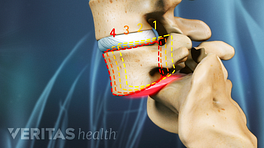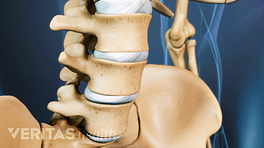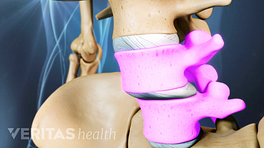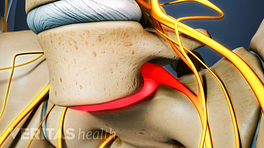Degenerative spondylolisthesis is a condition in which one vertebral body slips forward on top of the vertebral body below it, as a result of aging processes that weaken the spine. As a person ages, spinal discs tend to weaken and dry out, leading to arthritis that weakens the ligaments and joints of the spine.
As the facet joints at the back of the spine weaken, a vertebra may slip forward over the one below it. Degenerative spondylolisthesis occurs most frequently at the L4-L5 or L3-L4 segments of the spine, though it can occur at one to three levels simultaneously, and rarely in the cervical spine.
Many people do not have symptoms from degenerative spondylolisthesis. The most common source of pain from degenerative spondylolisthesis comes from a narrowing of the spinal canal. When the vertebra slips forward, it can compress nerve roots and cause low back pain or radiating pain.
Patients may also have a tired feeling in the legs or difficulty walking as a result of pinched nerves or tight hamstrings. Degenerative spondylolisthesis is linked to a number of other conditions, including arthritis and degenerative disc disease. Understanding its causes and symptoms is important to developing a treatment program with a doctor.
In This Article:
- Degenerative Spondylolisthesis
- Degenerative Spondylolisthesis Symptoms
- Degenerative Spondylolisthesis Treatment
- Surgery for Degenerative Spondylolisthesis
- Degenerative Spondylolisthesis Video










